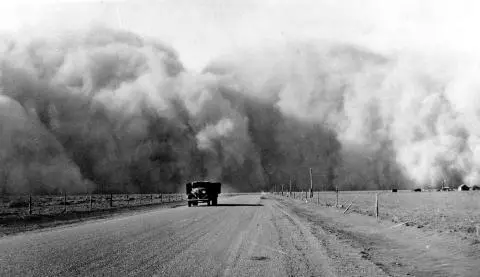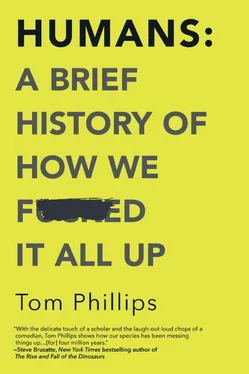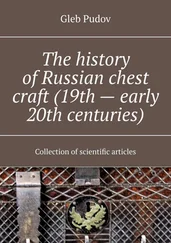Tom Phillips - Humans - A Brief History of How We F*cked It All Up
Здесь есть возможность читать онлайн «Tom Phillips - Humans - A Brief History of How We F*cked It All Up» весь текст электронной книги совершенно бесплатно (целиком полную версию без сокращений). В некоторых случаях можно слушать аудио, скачать через торрент в формате fb2 и присутствует краткое содержание. Город: Toronto, Год выпуска: 2019, ISBN: 2019, Издательство: Hanover Square Press, Жанр: История, Юмористические книги, на английском языке. Описание произведения, (предисловие) а так же отзывы посетителей доступны на портале библиотеки ЛибКат.
- Название:Humans: A Brief History of How We F*cked It All Up
- Автор:
- Издательство:Hanover Square Press
- Жанр:
- Год:2019
- Город:Toronto
- ISBN:978-1-48805-113-5
- Рейтинг книги:4 / 5. Голосов: 1
-
Избранное:Добавить в избранное
- Отзывы:
-
Ваша оценка:
- 80
- 1
- 2
- 3
- 4
- 5
Humans: A Brief History of How We F*cked It All Up: краткое содержание, описание и аннотация
Предлагаем к чтению аннотацию, описание, краткое содержание или предисловие (зависит от того, что написал сам автор книги «Humans: A Brief History of How We F*cked It All Up»). Если вы не нашли необходимую информацию о книге — напишите в комментариях, мы постараемся отыскать её.
Humans: A Brief History of How We F*cked It All Up — читать онлайн бесплатно полную книгу (весь текст) целиком
Ниже представлен текст книги, разбитый по страницам. Система сохранения места последней прочитанной страницы, позволяет с удобством читать онлайн бесплатно книгу «Humans: A Brief History of How We F*cked It All Up», без необходимости каждый раз заново искать на чём Вы остановились. Поставьте закладку, и сможете в любой момент перейти на страницу, на которой закончили чтение.
Интервал:
Закладка:
If that drive to farm every scrap of land doesn’t seem, with hindsight, like the greatest idea in the world, there were a bunch of reasons why people assumed it would be fine. There was the romantic—the nostalgic appeal of an agrarian nation of pioneers—and the pragmatic, a growing country’s basic need for food. But there was also some highly dodgy science, bordering on religion: the theory that “rain follows the plow,” that the simple act of starting to farm land would summon rain clouds, turning the desert fertile and verdant. Under this theory, the only thing stopping the expansion of farming in America was a lack of will. It’s like that Kevin Costner movie, but with cereal crops instead of ghosts playing baseball. If you farm it, rains will come.
They really believed in this, so it almost seems mean to point out that the reason it so often started raining as soon as farmers moved into an area was that the middle of the nineteenth century, when the theory was developed, was simply an unusually rainy period. Those rains, unfortunately, would not hang around forever.
Come World War I and suddenly all that farmland seemed like a great idea: Europe’s food production had ground to a halt, but America was able to pick up the slack. Prices were sky-high, the rains were good and the government kicked in some generous subsidies to farmers for planting wheat, so naturally farmers did, plowing up ever more prairie as they did so.
After the war, though, wheat prices fell dramatically. Now, if you’re a wheat farmer, and you’re not making enough money from your wheat, then the solution is obvious: you need to plant more wheat. Farmers invested in new mechanical plows, tearing up even more of the soil. Even more wheat meant even lower prices, which… and so on.
Then, suddenly, the rains didn’t come. The soil dried out, and the roots of the grasses that had held the topsoil together through previous droughts suddenly weren’t there. The soil turned to dust, and the wind picked that dust up into enormous, roiling clouds.
It’s those fearsome dust storms—the “black blizzards” that blotted out the sun, choked the air and reduced visibility to a few feet—that became the symbol of the Dust Bowl. In the worst years, hardly a day would go by in summer without the storms whipping up, and even when the wind died, the dust clouds would still hang in the sky. Sometimes residents barely saw the sun for days. The dust storms had astonishing range, with some of them traveling thousands of miles, blanketing cities like Washington, DC, and New York in a thick soil smog, and coating ships hundreds of miles off the East Coast with a fine layer of dust.
The drought and the dust storms persisted for almost a decade. It was economically ruinous, and several million people were forced to abandon their homesteads. Many never returned, settling instead even farther west, a large number in California. Some of the land never fully recovered, even when the rains came back.
The American Dust Bowl is one of the more famous examples of the unintended consequences of messing around with our environment. But from mass-scale geo-engineering to tiny plastic beads, from deforestation to rivers doing things that rivers definitely shouldn’t do, it’s not the only one.
Take the Aral Sea, for example—although you’ll have to move quickly, because there’s not a lot of it left to take.
The Aral Sea, despite its name prominently involving the word sea , is not actually a sea. Instead, it’s a saltwater lake, though a very, very large one—at over 26,000 square miles, one of the largest lakes in the world, or at least it was. The problem, you see, is that it is not 26,000 square miles anymore.

It’s now about 2,600 square miles, although that kind of goes up and down. Once almost the size of Ireland, it’s down to a tenth of its former size, and it’s lost over 80 percent of its water. It’s also not a single huge lake anymore—it’s now, roughly, four much smaller ones. “Roughly,” because one of the lakes may have vanished entirely. What little is left of the Aral Sea is now virtually dead, a lifeless ghost sea surrounded by the rusting and decaying skeletons of long-stranded ships that are now miles from any water.
Which prompts the question: How, exactly, do you lose an entire bloody sea? (Well, an entire big lake.)
The simple answer is: you divert the two rivers that used to flow into it, because you’ve had the bright idea of growing cotton in the desert. That’s what the Soviet authorities did from the 1960s onward, because they really wanted to have more cotton. So they undertook a huge project to redirect water from the Amu Darya (which flowed into the Aral Sea from Uzbekistan) and the Syr Darya (which reached the sea through Kazakhstan) so that the bone-dry plains of the Kyzylkum Desert could be converted into a monoculture that would supply the Soviet Union’s cotton needs. Now, in fairness, the plan to irrigate the wannabe farms of Turkmenistan, Kazakhstan and Uzbekistan was a partial success—albeit a hugely wasteful one, because the thing about deserts is that they’re quite dry and absorbent, so as much as 75 percent of the diverted river water never even made it to the farms. (There was also the issue of the defoliant chemicals used on the cotton, which caused sky-high rates of infant mortality and birth defects.)
But while this was good-ish news for the infant cotton industry of Central Asia, it was devastating for the Aral Sea and its surroundings. It doesn’t seem to have occurred to anybody—or they simply didn’t care—that when you stop water flowing into a lake, you quickly end up with much less lake.
Immediately from the sixties, but at an accelerating pace from the late eighties until the present day, the Aral Sea began to shrink. Only about a fifth of the water that had flowed into it before came from rainfall, with the rivers supplying the rest. So once they were virtually gone, there wasn’t enough water left to replace that lost to evaporation. The water level started dropping, and new islands and isthmuses began appearing; by the turn of the millennium, the lake had split into two: a small northern section and a larger southern section with a massive island in the middle of it. The waters kept falling, so that the island kept growing until only a tiny ribbon of water connected the eastern and western halves of the southern sea. Eventually they split, too, and then in the summer of 2014, satellite photographs revealed that the eastern section had dried up entirely, leaving only desert in its place. That eastern lake now just kind of comes and goes, depending on what the weather’s like.
This would have been bad enough, but the thing when a lake disappears is that all the stuff in the water… doesn’t. Salt, particularly. While the Aral Sea receded, the salt continued to hang around, making the waters saltier and saltier and less and less capable of supporting life. The salt density rocketed by a factor of ten, which killed virtually every living thing in the lakes, destroying a thriving fishing industry that had supported 60,000 jobs. Not just that, but the pollutants from industry and agriculture became more concentrated, and then got laid down on the exposed surface of new lands emerging as the waters drew back. Deserts being what they are, the wind then picked up tons and tons of toxic dust and salt from the newly arid landscape and dumped it right on the villages and towns surrounding the former lakes where millions of people lived. Respiratory disease and cancer shot up.
Читать дальшеИнтервал:
Закладка:
Похожие книги на «Humans: A Brief History of How We F*cked It All Up»
Представляем Вашему вниманию похожие книги на «Humans: A Brief History of How We F*cked It All Up» списком для выбора. Мы отобрали схожую по названию и смыслу литературу в надежде предоставить читателям больше вариантов отыскать новые, интересные, ещё непрочитанные произведения.
Обсуждение, отзывы о книге «Humans: A Brief History of How We F*cked It All Up» и просто собственные мнения читателей. Оставьте ваши комментарии, напишите, что Вы думаете о произведении, его смысле или главных героях. Укажите что конкретно понравилось, а что нет, и почему Вы так считаете.












